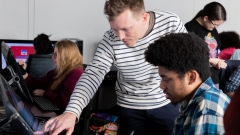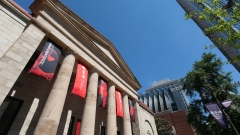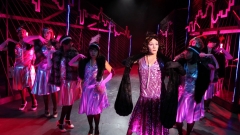Optimizing Creative Work: Tips to Connect, Simplify and Champion Teams
January 27, 2020
By: Alisha Miranda
Overseeing digital projects and wrangling creative teams demand the right tools and techniques for delivering on-time, quality work. In my career, I’ve seen the most successful project teams be comprised of both creatives and non-creatives who collaborate and align on a belief that there is a better way to get the work done. Below is my playbook for team leads with helpful tips and lessons learned to achieving creative success. Bonus: if executed well, rewarding outcomes lay ahead not only for your internal teams, but your clients.
1. Choose collab sessions instead of meetings
The less meetings, the better. Excessive Meetings can be detrimental due to context switching, or when invitees are not actively engaged or aware of the objective or their roles. Instead of meetings, coordinate ideation or collaborative working sessions where creatives can connect on the task at hand.
Here are five guidelines for making creative ideation impactful:
-
Educate teams on key performance indicators during Creative kickoffs. How will Creative work be considered a success? What benchmarks or objectives must be met? What does it mean to be on brief?
-
Be open to problem solving. Ask: What creative blockers are there? What can we do right now? How can we simplify process?
-
Connect offline. Schedule walk and talks, mindful breaks, or brainstorming off–site. Sometimes a change of scenery renews energy and inspiration!
-
Write it down. Document important notes, recaps, decisions during critical discussion points. One way to do this is to communicate early and often and be transparent about the creative work-in-progress.
-
Ask if a session was productive at the end. If Creatives can handle doing the work without setup sessions or meetings, give them the space to do so. If not, figure out another format where everyone is comfortable working together.
2. Standardize creative reviews
Once creatives feel good about executing the work, setup a workflow to present and review. Quality control and accuracy checkpoints are instrumental in ensuring creative work not only meets objectives but is polished. This is where standardizing creative reviews comes handy. From copyediting drafts to asset inventory checklists, following a QA/QC workflow involves everyone’s accountability to submit top-notch work consistently.
Here are four rules to keep creative reviews on track:
-
Incorporate creative asset inventory discussions during kickoffs. Take time to determine what is needed to produce Creative like client or brand imagery, style guides, competitive analysis, market research outcomes, video links and more. The goal is to make sure the team has what they need to begin the work.
-
No thoughts or feelings! When providing feedback, be specific, ask targeted questions and give clear direction for Creative to action against. Refrain from sharing personal opinions or subjective feedback that’s open for interpretation. Provide examples or screengrabs whenever possible.
-
Always do a full read. Tap others for additional support in proofreading or copyediting work from top to bottom. This extra step will catch glaring errors like spelling and grammar, but also brand or style guidelines, and other 'must match’ requirements.
-
Assign a RACI matrix of decision makers. Specify who is reviewing what and why. Express what creative decisions need to be made, by whom, and when: who is responsible, accountable, consulted, or informed. For example, senior leadership is consulted at a higher level once the work is in a good place, versus junior team members who are responsible for executing the work at all stages.
3. Be agile whenever possible
As much as I love process (I am a Project Manager by discipline, after all!) I have to remember to be nimble and encourage flexibility. When producing creative work, there are no shortages of unexpected twists and turns that can derail your plans. At the same time, there are also opportunities to be iterative and efficient, no matter the challenge. Over the years I’ve learned how to tweak timelines and empower others to manage expectations. The key is to remain open-minded throughout the creative process.
Here are three ways to trust the process:
-
Think of Creative Development phases as taking frequent, small steps and iterations or “sprints.” Being creative means presenting and revising work regularly so be fluid when determining tasks and their accompanying due dates.
-
Treat major milestones as “releases” or “progression” goals. If you work in digital you may have heard of “waterfall” versus “agile” approaches. One is more dependency-driven with specific cadences to completing tasks, while the other provides freedom to experiment in how and when work is delivered. Establish the points of focus throughout the creative lifecycle.
-
Iterate, adapt, collaborate, and refine til everyone feels good about the end result.
Now that you have a playbook for forging better creative partnerships, go forth and conquer!
- - - - - -
Alisha Miranda is a writer & project manager whose work spans digital media, editorial, technology and marketing. Before moving to Philadelphia, she made her rounds at ad agencies, publishing houses and startups in New York City leading content studio teams. She’s been running #alishainthebiz as a one-woman HQ on the side since 2010 to consult on content development, brand partnerships and digital strategy. She now proudly calls South Philly home where she can be found eating, drinking and biking.





